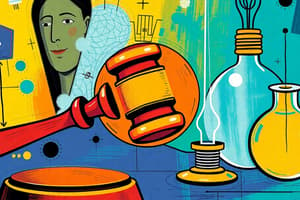Podcast
Questions and Answers
What is the main purpose of a patent?
What is the main purpose of a patent?
- To limit the inventor's rights over the invention
- To share the invention with the public for free
- To exclude others from making, using, or selling the invention (correct)
- To promote competition among inventors
Which of the following is a requisite for a Design Patent?
Which of the following is a requisite for a Design Patent?
- Novelty and Industrial Applicability
- Novelty and Ornamentality (correct)
- Novelty and Inventive Step
- Inventive Step and Industrial Applicability
What type of inventions are considered non-patentable?
What type of inventions are considered non-patentable?
- Discoveries and scientific theories (correct)
- Micro-organisms and microbiological processes
- Methods for treatment of human body by surgery or therapy
- Products related to industrial applicability
In order for an invention to be patentable, it must involve ___.
In order for an invention to be patentable, it must involve ___.
Which of the following is explicitly excluded from patent protection?
Which of the following is explicitly excluded from patent protection?
What types of processes are exempted from non-patentable inventions regarding plant varieties or animal breeds?
What types of processes are exempted from non-patentable inventions regarding plant varieties or animal breeds?
Who can disclose information without prejudicing the novelty of a patent application?
Who can disclose information without prejudicing the novelty of a patent application?
What is required for an invention to have an inventive step?
What is required for an invention to have an inventive step?
When can the disclosure of information in a patent application prejudice the applicant?
When can the disclosure of information in a patent application prejudice the applicant?
What type of invention is considered industrially applicable?
What type of invention is considered industrially applicable?
What does it mean for an invention to lack novelty?
What does it mean for an invention to lack novelty?
Who can make a disclosure of information that would not affect the novelty of a patent application?
Who can make a disclosure of information that would not affect the novelty of a patent application?
Who owns the patent if a person commissions the work?
Who owns the patent if a person commissions the work?
Under what condition does the patent belong to the employee when the invention is made during employment?
Under what condition does the patent belong to the employee when the invention is made during employment?
What happens if a patent is granted within 1 year of its publication?
What happens if a patent is granted within 1 year of its publication?
When does the filing date of a new patent application retroact to?
When does the filing date of a new patent application retroact to?
What is different about copyright ownership compared to patent ownership when work is commissioned?
What is different about copyright ownership compared to patent ownership when work is commissioned?
What is the term of a patent from its filing date?
What is the term of a patent from its filing date?
What exclusive right does a patent confer when the subject matter is a product?
What exclusive right does a patent confer when the subject matter is a product?
When is the owner of a patent not able to prevent third parties from performing certain acts?
When is the owner of a patent not able to prevent third parties from performing certain acts?
Which of the following is NOT a limitation of patent rights for the owner?
Which of the following is NOT a limitation of patent rights for the owner?
What is a scenario where the owner of a patent cannot prevent others from using a patented product?
What is a scenario where the owner of a patent cannot prevent others from using a patented product?
What does a patent owner have the right to assign or transfer?
What does a patent owner have the right to assign or transfer?
Under what circumstances can third parties use a patented product without authorization?
Under what circumstances can third parties use a patented product without authorization?
What rights does a prior user have in relation to an invention?
What rights does a prior user have in relation to an invention?
Under what circumstances can a government agency exploit an invention without the patent owner's agreement?
Under what circumstances can a government agency exploit an invention without the patent owner's agreement?
What constitutes patent infringement according to the text?
What constitutes patent infringement according to the text?
Which entity can determine that the manner of exploitation by the patent owner is anti-competitive?
Which entity can determine that the manner of exploitation by the patent owner is anti-competitive?
Can a prior user transfer their rights to use an invention separately from their business?
Can a prior user transfer their rights to use an invention separately from their business?
What specific qualifications must a prior user meet to have rights in relation to an invention?
What specific qualifications must a prior user meet to have rights in relation to an invention?
Flashcards are hidden until you start studying




